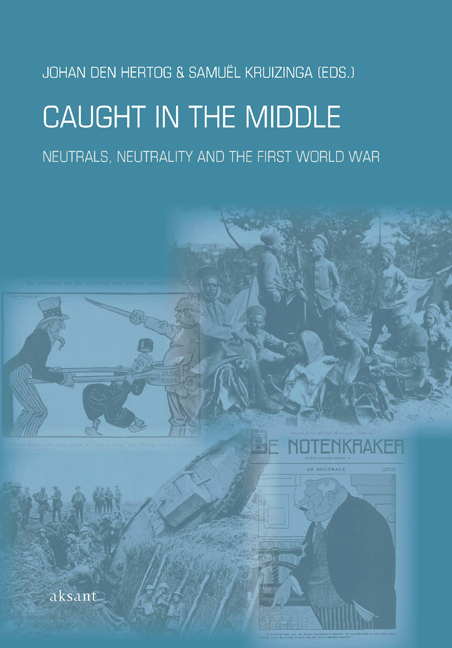Book contents
- Frontmatter
- Contents
- Acknowledgements
- Chapter 1 Introduction
- Chapter 2 Dutch Neutrality and the Value of Legal Argumentation
- Chapter 3 ‘Upon the Neutral Rests the Trusteeship of International Law’: Legal advisers and American unneutrality
- Chapter 4 Spanish Neutrality During the First World War
- Chapter 5 Britain’s Global War and Argentine Neutrality
- Chapter 6 NOT Neutrality: The Dutch government, the Netherlands Oversea Trust Company, and the Entente blockade of Germany, 1914-1918
- Chapter 7 From Parasite to Angel: Narratives of neutrality in the Swedish popular press during the First World War
- Chapter 8 Colour-blind or Clear-sighted Neutrality?: Georg Brandes and the First World War
- Chapter 9 The Hottest Places in Hell?: Finnish and Nordic neutrality from the perspective of French foreign policy, 1900-1940
- Chapter 10 The Other End of Neutrality: The First World War, the League of Nations, and Danish neutrality
- About the Contributors
Chapter 9 - The Hottest Places in Hell?: Finnish and Nordic neutrality from the perspective of French foreign policy, 1900-1940
Published online by Cambridge University Press: 28 January 2021
- Frontmatter
- Contents
- Acknowledgements
- Chapter 1 Introduction
- Chapter 2 Dutch Neutrality and the Value of Legal Argumentation
- Chapter 3 ‘Upon the Neutral Rests the Trusteeship of International Law’: Legal advisers and American unneutrality
- Chapter 4 Spanish Neutrality During the First World War
- Chapter 5 Britain’s Global War and Argentine Neutrality
- Chapter 6 NOT Neutrality: The Dutch government, the Netherlands Oversea Trust Company, and the Entente blockade of Germany, 1914-1918
- Chapter 7 From Parasite to Angel: Narratives of neutrality in the Swedish popular press during the First World War
- Chapter 8 Colour-blind or Clear-sighted Neutrality?: Georg Brandes and the First World War
- Chapter 9 The Hottest Places in Hell?: Finnish and Nordic neutrality from the perspective of French foreign policy, 1900-1940
- Chapter 10 The Other End of Neutrality: The First World War, the League of Nations, and Danish neutrality
- About the Contributors
Summary
Dante once said that the hottest places in hell are reserved for those who in a period of moral crisis maintain their neutrality.
John F. KennedyWhat better introduction could we find to our subject than this (mis)quote of Dante Alighieri by us President John Fitzgerald Kennedy, pronounced in 1963 in relation to the creation of the German Peace Corps? Indeed, from the point of view of a great power engaged in the Cold War, the neutrality of smaller states can easily appear to be a dangerous liability, a crack in the armour to be used by the enemy. The moral tinge of Kennedy's remark is also interesting: when good and evil, democracy and authoritarianism fight, how can one remain neutral?
This opens the debate of why and how neutrality is conceived, respected, or violated by other states, especially by great powers. Although the concept gained legal definition during the eighteenth and nineteenth century, neutrality was and remains construed by the general context of international relations. The goal of this article is to concentrate on this vision of neutrality from the outside. The specific case we will examine is the French vision of Nordic neutralities, especially Finland’s, during the years 1917-1940. For various reasons linked with language and a perceived lack of substance, French policy in the north of Europe remains a blind spot in historical research both in French and in English. To be sure, France in the first half of the twentieth century did not have the same presence in the region as Great Britain or Germany. The French, however, were far from inactive, and their relation with Nordic neutrality presents interesting features for the researcher. In many ways, the French vision of Nordic neutrality gives us a textbook example of the ambiguities surrounding external visions of neutrality.
Scandinavian neutrality before 1914
‘Scandinavian neutrality’ became an issue for the French foreign policy leadership at the turn of the century, between the forging of the Russian alliance (1891-1892) and the beginning of World War I. From Paris, Northern Europe and the Baltic Sea appeared to be distant regions where French foreign policy moved between the warding off of German influence, the preservation of the Baltic as an open sea, and attempts at organizing co-operation, mostly between Russia and England.
- Type
- Chapter
- Information
- Caught in the MiddleNeutrals, Neutrality and the First World War, pp. 139 - 154Publisher: Amsterdam University PressPrint publication year: 2012



